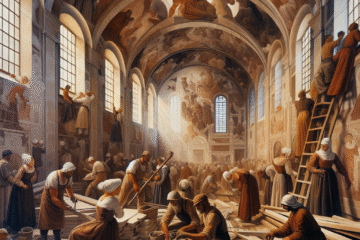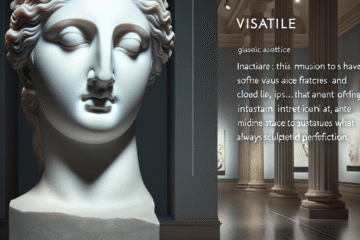I. Introduction
- Brief overview of the significance of ancient Greece in the history of Western art
- Purpose of the article: to examine the artistic legacy of ancient Greece and its enduring influence on Western art
The ancient Greeks are widely regarded as one of the most influential civilizations in the history of Western art. Their artistic achievements, including architecture, sculpture, painting, and pottery, have had a profound impact on subsequent art movements in the Western world. The legacy of ancient Greek art can be seen in the works of some of the greatest artists of all time, from Michelangelo and Leonardo da Vinci to the neoclassical artists of the 18th and 19th centuries.
The significance of ancient Greece in the history of Western art cannot be overstated. The Greeks were the first civilization to create art purely for its own sake, rather than as a means of conveying religious or political messages. This shift in artistic purpose led to the development of a new set of aesthetic values, centered on the idealization of the human form, the representation of beauty, and the celebration of individuality.
Ancient Greek art also played a crucial role in the development of Western art techniques and styles. Greek artists pioneered new methods of sculpting and painting that were later adopted by artists across Europe. The Greek emphasis on realism and naturalism, as well as their innovative use of perspective and composition, laid the foundation for many subsequent art movements, including the Renaissance and the neoclassical period.
The purpose of this article is to examine the enduring influence of ancient Greek art on Western art. By exploring the context of ancient Greek art, the legacy of this art in subsequent art movements, the themes and motifs that have endured over time, and the critiques and limitations of this art, we can gain a deeper understanding of the ongoing importance of studying ancient Greek art in the modern world.
Overall, the legacy of ancient Greece in the history of Western art is a testament to the enduring power and relevance of the artistic achievements of this remarkable civilization. Through careful examination and analysis of ancient Greek art, we can gain a deeper appreciation for the beauty, complexity, and enduring influence of this art on the Western world.
II. The Context of Ancient Greek Art
- Historical and cultural background of ancient Greece
- Major artistic achievements and characteristics of ancient Greek art
Ancient Greece is often regarded as the cradle of Western civilization, with a rich history and cultural legacy that has shaped the world we know today. The ancient Greeks left behind a wealth of artistic achievements that continue to inspire and influence artists around the world. In this article, we will explore the historical and cultural background of ancient Greece and the major artistic achievements and characteristics of ancient Greek art.
Historical and Cultural Background of Ancient Greece Ancient Greece was a collection of independent city-states, including Athens, Sparta, Corinth, and Thebes, each with its own unique political and cultural traditions. Ancient Greece was known for its love of democracy, philosophy, and literature, and was home to some of the most brilliant minds in history, including Aristotle, Plato, and Socrates. Greek culture also celebrated physical prowess and athleticism, with the Olympic Games being a testament to this legacy.
Major Artistic Achievements and Characteristics of Ancient Greek Art Ancient Greek art is known for its emphasis on realism, naturalism, and idealism. Ancient Greek artists sought to capture the beauty and perfection of the human form, portraying both men and women in their idealized forms. Greek art was characterized by a sense of harmony and balance, with a focus on symmetry and proportion. This aesthetic was evident in all forms of Greek art, from architecture to sculpture, pottery, and painting.
Architecture was one of the major artistic achievements of ancient Greece, with iconic structures like the Parthenon in Athens and the Temple of Apollo at Delphi still standing today. Greek architects developed new techniques for constructing buildings, including the use of columns and pediments, which became hallmarks of classical architecture. Greek temples were typically designed to honor the gods and goddesses, and their architectural features were meant to evoke a sense of divine grandeur and power.
Sculpture was another major artistic achievement of ancient Greece, with some of the most iconic and recognizable sculptures in history originating from this period. Greek sculptors were known for their mastery of the human form, and their sculptures often depicted mythological scenes or famous historical figures. One of the most famous examples of Greek sculpture is the statue of David, created by the sculptor Phidias in the 5th century BC.
In addition to architecture and sculpture, ancient Greek art also included pottery and painting. Greek pottery was known for its intricate designs and patterns, with vessels often featuring scenes from Greek mythology or everyday life. Greek painting was less well-preserved than other forms of art, but surviving examples suggest that it was highly naturalistic and focused on capturing the beauty and complexity of the world around them.
Overall, the historical and cultural background of ancient Greece and the major artistic achievements and characteristics of ancient Greek art are crucial to understanding the legacy of this remarkable civilization. The Greeks left behind a wealth of artistic and cultural treasures that continue to inspire and influence artists and scholars around the world.
III. The Legacy of Ancient Greek Art in Western Art
- Influence of ancient Greek art on subsequent art movements in the Western world
- Examples of specific artworks or artists that demonstrate this influence (e.g. the Parthenon, Michelangelo’s David, neoclassical art)
Ancient Greek art has had a profound and enduring influence on subsequent art movements in the Western world. From the Renaissance to the neoclassical period, artists and architects have drawn inspiration from the timeless beauty and complexity of ancient Greek art. In this article, we will explore the legacy of ancient Greek art in Western art and highlight specific artworks and artists that demonstrate this influence.
Influence of Ancient Greek Art on Subsequent Art Movements in the Western World The influence of ancient Greek art can be seen in virtually every major art movement in the Western world. During the Renaissance, artists such as Leonardo da Vinci and Michelangelo were deeply inspired by the classical aesthetic of ancient Greek art, and sought to revive its techniques and styles in their own works. This led to a renewed interest in realism, naturalism, and idealism, as well as a focus on the beauty and perfection of the human form.
In the 18th and 19th centuries, the neoclassical art movement further cemented the enduring legacy of ancient Greek art in Western art. Neoclassical artists sought to revive the classical aesthetic of ancient Greece and Rome, using it to express the ideals of reason, order, and morality. This movement was characterized by a return to classical themes and motifs, as well as a renewed emphasis on harmony, balance, and proportion.
Examples of Specific Artworks or Artists that Demonstrate the Influence of Ancient Greek Art The Parthenon, located in Athens, Greece, is one of the most iconic examples of ancient Greek architecture, and has served as a source of inspiration for countless artists and architects over the centuries. Its columns, pediments, and friezes have been replicated in buildings around the world, from the British Museum in London to the U.S. Capitol Building in Washington, D.C.
Michelangelo’s David, created in the 16th century, is one of the most famous sculptures in history and a prime example of the influence of ancient Greek art on Renaissance artists. The statue, which depicts the biblical hero David, is noted for its idealized form, classical proportions, and realistic detailing, all hallmarks of the ancient Greek aesthetic.
Neoclassical art also drew heavily on the legacy of ancient Greek art, with artists such as Jacques-Louis David and Jean-Auguste-Dominique Ingres using classical themes and motifs in their works. David’s painting, The Death of Socrates, is a prime example of this, depicting the famous Greek philosopher as a martyr for his beliefs, and capturing the stoic dignity and moral courage that were so highly valued in ancient Greek culture.
Overall, the legacy of ancient Greek art in Western art is a testament to the enduring power and influence of this remarkable civilization. From the Renaissance to the neoclassical period, artists and architects have drawn inspiration from the timeless beauty and complexity of ancient Greek art, and have used it to express their own creative visions and ideas.
IV. Themes and Motifs in Ancient Greek Art
- Examination of common themes and motifs in ancient Greek art (e.g. humanism, idealism, mythological subjects)
- How these themes and motifs have been adapted and transformed in Western art over time
Ancient Greek art is known for its iconic themes and motifs that have stood the test of time and continued to inspire artists for centuries. From humanism and idealism to mythological subjects and depictions of nature, ancient Greek art is characterized by a distinct set of values and ideas that continue to influence Western art today. In this article, we will examine the common themes and motifs in ancient Greek art and explore how they have been adapted and transformed in Western art over time.
Common Themes and Motifs in Ancient Greek Art One of the most enduring themes in ancient Greek art is humanism, the idea that the human form is the highest expression of beauty and perfection. Greek artists sought to capture the idealized human form in their sculptures, paintings, and pottery, portraying both men and women in their idealized forms. This emphasis on the human form has been a constant presence in Western art, from the Renaissance to contemporary art.
Another important theme in ancient Greek art is idealism, the idea that beauty and perfection can be achieved through art and culture. Greek art was characterized by a sense of harmony and balance, with a focus on symmetry and proportion. This aesthetic has been a hallmark of Western art, influencing everything from architecture to painting and sculpture.
Mythological subjects were also a common theme in ancient Greek art, with gods, goddesses, and heroes often depicted in sculptures and paintings. These mythological figures were often depicted in idealized forms, embodying the values and ideals of Greek culture. This focus on mythological subjects has been a constant presence in Western art, inspiring artists from Botticelli to Rembrandt to Salvador Dali.
Depictions of nature were also a common theme in ancient Greek art, with landscapes and seascapes often portrayed in pottery and painting. Greek artists were known for their attention to detail and their ability to capture the natural beauty of the world around them. This focus on nature has been a constant presence in Western art, influencing everything from landscape painting to still life to environmental art.
Adaptations and Transformations of Themes and Motifs in Western Art The themes and motifs of ancient Greek art have been adapted and transformed in Western art over time, reflecting the changing values and ideals of Western culture. During the Renaissance, for example, artists sought to revive the classical aesthetic of ancient Greece, using it to express the ideals of reason, order, and morality. This led to a renewed interest in realism, naturalism, and idealism, as well as a focus on the beauty and perfection of the human form.
In the 20th century, artists began to reinterpret and transform the themes and motifs of ancient Greek art in new and innovative ways. Modernist artists like Pablo Picasso and Henri Matisse rejected the idealized forms and harmonious compositions of ancient Greek art, instead embracing new forms of expression and experimentation. This led to the development of new art movements like Cubism, Surrealism, and Abstract Expressionism, each of which drew on the legacy of ancient Greek art in its own unique way.
Overall, the themes and motifs of ancient Greek art continue to inspire and influence Western art today, serving as a constant reminder of the enduring power and beauty of this remarkable civilization. Whether through humanism, idealism, mythological subjects, or depictions of nature, the legacy of ancient Greek art continues to shape and transform the artistic landscape of the Western world.
V. Criticisms and Limitations of Ancient Greek Art
- Discussion of critiques or limitations of ancient Greek art, both contemporary and modern
- Acknowledgment of the problematic elements of ancient Greek art (e.g. exclusion of women and non-Greeks from artistic representation)
While ancient Greek art has had a profound and enduring influence on Western art, it is not without its criticisms and limitations. From contemporary critiques to modern-day reflections, there are several aspects of ancient Greek art that have been called into question, including its exclusionary tendencies and its lack of diversity. In this article, we will explore the critiques and limitations of ancient Greek art, both contemporary and modern.
Contemporary Critiques of Ancient Greek Art One of the main criticisms of ancient Greek art is its exclusionary tendencies. Ancient Greek art was created by and for the ruling class of Greek society, with women and non-Greeks often excluded from artistic representation. This exclusionary tendency has been criticized for perpetuating the values and ideals of the ruling class, while marginalizing and erasing the experiences of other groups.
Another critique of ancient Greek art is its emphasis on idealized forms and perfection, which some argue can be oppressive and limiting. This focus on perfection has been criticized for promoting unrealistic standards of beauty and perpetuating harmful notions of body image and self-worth.
Modern Critiques of Ancient Greek Art In addition to contemporary critiques, modern-day reflections on ancient Greek art have also raised questions about its limitations and problematic elements. One of the main criticisms of ancient Greek art is its lack of diversity, both in terms of representation and artistic styles. While Greek art is often celebrated for its beauty and sophistication, it is also criticized for its homogeneity and lack of diversity.
Another criticism of ancient Greek art is its focus on the male gaze, with women often depicted as passive objects of male desire. This objectification of women has been criticized for perpetuating harmful gender stereotypes and reinforcing patriarchal power structures.
Acknowledging Problematic Elements of Ancient Greek Art While it is important to acknowledge the problematic elements of ancient Greek art, it is also important to recognize the contributions that it has made to the artistic and cultural landscape of the Western world. By acknowledging the limitations and critiques of ancient Greek art, we can gain a deeper understanding of its complexities and appreciate its legacy in a more nuanced way.
Overall, the critiques and limitations of ancient Greek art serve as a reminder of the need for diversity, inclusivity, and representation in art and culture. While ancient Greek art is not without its flaws, it has played an important role in shaping the artistic and cultural landscape of the Western world, and continues to inspire and influence artists today. By examining its limitations and critiques, we can gain a deeper appreciation for its complexity and ongoing relevance.
VI. Conclusion
- Recap of the enduring legacy of ancient Greek art in Western art
- Reflection on the ongoing relevance and importance of studying ancient Greek art in the modern world.
Ancient Greek art is a testament to the enduring power and beauty of one of the most remarkable civilizations in history. Its legacy has had a profound and ongoing influence on Western art, shaping artistic techniques, styles, and themes for centuries. From the idealized forms of sculpture and painting to the harmony and balance of architecture, the enduring legacy of ancient Greek art is a constant source of inspiration and reflection for artists and scholars around the world.
The enduring legacy of ancient Greek art in Western art is a testament to its ongoing relevance and importance in the modern world. By studying the art of ancient Greece, we gain a deeper understanding of the values, beliefs, and cultural traditions that have shaped the Western world. We learn to appreciate the beauty and complexity of this remarkable art, and to recognize its ongoing influence on contemporary art and culture.
Moreover, by acknowledging the critiques and limitations of ancient Greek art, we gain a more nuanced and complex understanding of this art and its legacy. We learn to appreciate its complexities and contradictions, to recognize the need for diversity and inclusivity in art and culture, and to engage in critical reflection on the role of art in society.
In conclusion, the enduring legacy of ancient Greek art in Western art is a testament to its enduring power and relevance. By studying this remarkable art, we gain a deeper appreciation for the beauty, complexity, and diversity of the Western artistic tradition, and learn to engage in critical reflection on its ongoing role in shaping our world.


